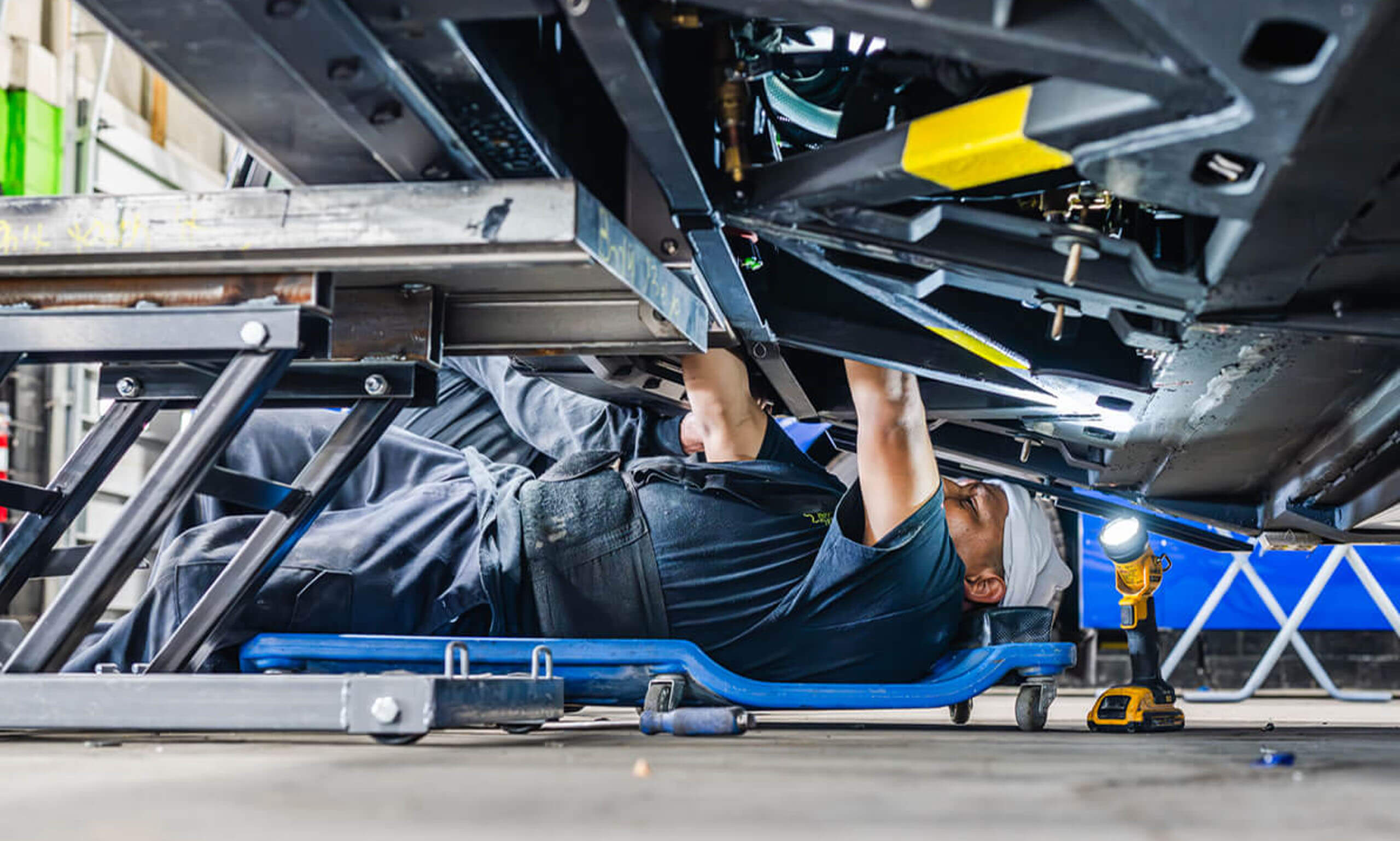Suspension problems account for thousands of breakdowns and delays every year—many of them completely preventable. When it comes to bus suspension repair, waiting until something breaks is never a good strategy.
Your suspension system keeps the bus stable and safe, so when it’s not working right, it can lead to a whole host of problems — from poor ride quality to safety hazards that put everyone at risk. By recognizing the symptoms early on, you’ll save yourself time, money, and avoid those emergency breakdowns that no one ever wants.
1. Uneven Tire Wear: A Major Red Flag
One of the most common signs that your bus suspension needs attention is uneven tire wear. You’ve probably heard this before — tires naturally wear down over time, especially if you’re putting miles on your buses every day. But when the wear isn’t uniform, you’ve got a problem.
The suspension system helps keep the bus level and ensures even distribution of weight across the wheels. If something is off with the suspension, the tires will wear out faster in certain areas, which can lead to costly tire replacements and safety issues.
What to Look For
- Bald spots on tires or uneven tread depth.
- Significant wear along the inner or outer edges of your tires.
- Increased tire noise or vibration when driving.
If you notice any of these signs, it’s time to check the suspension. This kind of wear can be a sign of misalignment, worn shocks, or damaged springs. Ignoring it can lead to more serious problems down the road, like tire blowouts or compromised handling.
Early detection of uneven tire wear can save you thousands on premature tire replacements. It can also keep your buses running more smoothly, which is crucial for passenger comfort and safety. By addressing the issue promptly, you’ll ensure your tires last longer and avoid dangerous driving conditions.
2. Bouncy Ride or Poor Handling: Not Just a Comfort Issue
Ever been on a bus that feels like a roller coaster? A bouncy ride or poor handling isn’t just uncomfortable; it’s a clear indication that something is wrong with the suspension system. If your bus is bouncing excessively when crossing bumps or swaying during turns, it likely means your shock absorbers, struts, or springs are worn out and unable to properly absorb and control the movement.
Your suspension system is meant to cushion the impact of rough roads and keep the vehicle stable during turns, braking, and acceleration. If it’s not doing its job, not only does the ride quality suffer, but it also puts your passengers’ safety at risk.
What to Look For
- The bus sways or bounces uncontrollably when going over bumps.
- Difficulty controlling the bus during turns, especially at higher speeds.
- A noticeable increase in the feeling of “tilting” when driving over uneven surfaces.
A bouncy ride isn’t just annoying — it’s a red flag that your suspension components are worn out or malfunctioning. Fixing the issue sooner rather than later will not only improve the ride comfort but also reduce the risk of accidents and improve handling, which is crucial for fleet safety.
3. Leaking Fluid Around Shock Absorbers or Struts
If you notice oil or hydraulic fluid leaking from around the shock absorbers or struts, it’s time to schedule some bus suspension repair. Shocks and struts rely on hydraulic fluid to function properly, and when seals break or wear out, the fluid leaks out, rendering the suspension component ineffective.
Without functioning shocks or struts, your bus will not be able to absorb shocks from the road, which can lead to a jarring ride and excessive wear on other components.
What to Look For
- Oil or hydraulic fluid pooling near the shocks or struts.
- Visible oil or fluid stains around suspension components.
- Dips or unusual movements when driving over bumps or potholes.
Fluid leaks are one of the most direct indicators that your suspension needs repair. A bus with leaking shock absorbers will struggle to provide a smooth and controlled ride.
Fixing this early can prevent more serious damage to the suspension system, and it’ll ensure the safety and comfort of your passengers.
4. Unusual Noises: Clunking, Squeaking, or Grinding Sounds
Suspension systems are complex, with a variety of components working together to ensure a smooth ride. When one or more parts of the suspension system start to fail, it’s common to hear clunking, squeaking, or even grinding noises.
These noises often come from worn-out bushings, ball joints, or springs that are either loose or damaged. They might seem like just an inconvenience at first, but if left unchecked, these noises will usually get worse and lead to more significant issues.
What to Look For
- Clunking sounds when you drive over bumps or potholes.
- Squeaking or squealing sounds when turning or braking.
- Grinding noises when accelerating or stopping.
Don’t just “live with” strange noises from your suspension system. They are warning signs that something is wrong and need to be addressed immediately.
Ignoring these noises will only lead to bigger, more expensive repairs later on. If you’re hearing any of these sounds, it’s time to have your bus inspected by a professional mechanic.
5. Leaning or Uneven Ride Height: Your Bus Might Be Sagging
Leaning or sagging on one side of the bus is one of the most noticeable and serious signs that you need bus suspension repair. If the bus is tilting to one side or sagging in the rear, there’s a good chance that the suspension system has failed in that area.
Broken springs, worn-out air suspension components, or damaged shock absorbers can all lead to these issues. Not only does it affect the appearance and comfort of your bus, but it also creates an unstable driving experience that’s unsafe for both the driver and passengers.
What to Look For
- The bus leaning noticeably to one side, even when it’s empty.
- Rear sagging or a noticeable drop in height when the bus is loaded.
- Shifting or uneven weight distribution during driving.
Leaning or sagging is a serious safety concern. A bus that’s not sitting level is at higher risk of tipping over, especially when cornering or braking suddenly. If you notice any of these signs, schedule a bus suspension repair as soon as possible to restore proper balance and handling.
Don’t Overlook Regular Suspension Inspections
One of the best ways to avoid costly bus suspension repair is to keep up with regular inspections and maintenance. Suspension problems often develop gradually over time, and by the time you notice them, they may have already caused significant damage. Regular diagnostics can catch early signs of wear, such as minor leaks or misalignment, before they turn into big problems.
At NEBR, we specialize in preventive maintenance that helps our clients stay ahead of suspension issues. By using comprehensive fleet diagnostics and monitoring bus mileage and usage, we can pinpoint potential problems early and take action to avoid costly repairs down the road.
Keep Your Buses Safe and Running Smoothly
A well-functioning suspension system is crucial for the safety, comfort, and longevity of your buses. Ignoring the signs that your bus needs suspension repair can lead to unsafe conditions, higher repair costs, and more downtime for your fleet. By paying attention to these 5 signs and addressing any issues early, you’ll save yourself money and keep your passengers comfortable and safe.
If you notice any of these issues with your buses, don’t wait. Contact us today at NEBR for a professional bus suspension repair consultation, and let us help you keep your fleet running smoothly and safely.
Ready to get your suspension checked? Schedule an appointment with NEBR today!
FAQ: Bus Suspension Repair
How often should I get my bus suspension checked?
It’s recommended to inspect your bus suspension every 12,000 to 15,000 miles, or at least once a year, depending on usage. Regular checks can help catch issues early before they become costly repairs, and can prevent unexpected breakdowns that could affect the safety and comfort of your passengers.
What happens if I ignore bus suspension issues?
Ignoring bus suspension issues can lead to a range of problems, from poor ride quality and increased tire wear to unsafe driving conditions. In the worst cases, a failing suspension could cause a complete system failure, which might result in costly repairs, downtime, and even accidents.
Can a damaged bus suspension affect tire life?
Yes, a damaged or misaligned suspension can lead to uneven tire wear. When the suspension is not functioning properly, it causes the tires to wear out faster on certain areas, which can lead to premature tire replacements and potential safety risks.
What are the risks of driving with a damaged bus suspension?
Driving with a damaged bus suspension can lead to a range of serious issues, including poor handling, uneven tire wear, and compromised passenger safety. A failing suspension can affect braking, cornering, and overall vehicle stability, increasing the risk of accidents or breakdowns. Additionally, it can cause damage to other vehicle components, like tires and the drivetrain, leading to even more costly repairs down the line.
How can I tell if my suspension repair will be expensive?
The cost of bus suspension repair depends on the severity of the issue. Minor repairs, such as replacing shocks or struts, are generally less expensive, while more extensive repairs, like replacing springs or addressing structural damage, can be more costly. Scheduling an inspection as soon as you notice symptoms can help prevent more extensive damage and give you a better idea of what repairs will be necessary.













